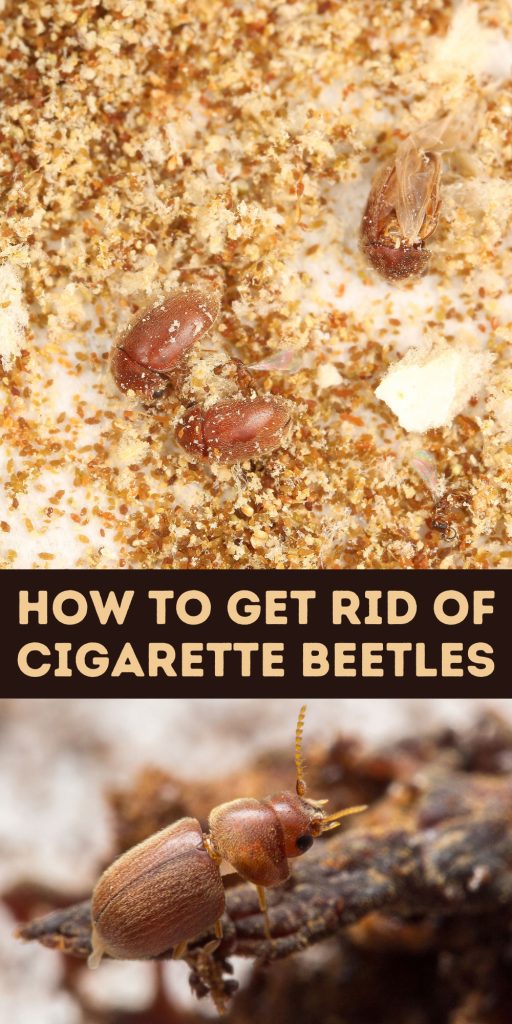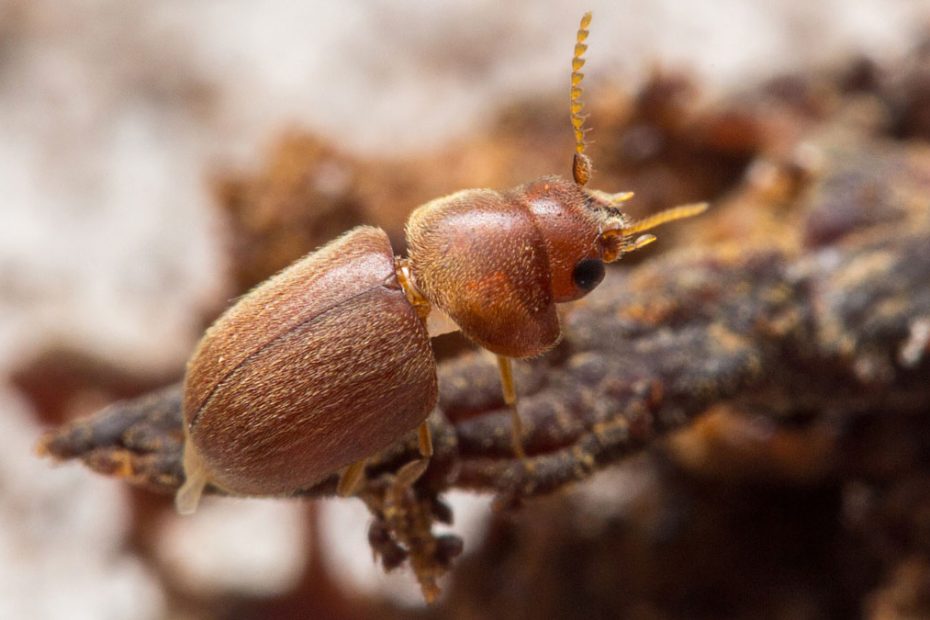Finding tiny, reddish-brown beetles around your pantry or stored goods can be unsettling. These pests, known as cigarette beetles, don’t just target tobacco; they also feast on a variety of dried foods and spices. If you’ve spotted them in your home, you’re likely wondering how to get rid of them quickly and effectively.
Cigarette beetles can cause significant damage to your stored products, leading to both financial loss and frustration. Fortunately, there are proven methods to eliminate these pests and prevent future infestations. By understanding their habits and taking proactive steps, you can reclaim your pantry and keep your food safe.
Key Takeaways
- Identify Infestation: Look for signs such as visible beetles, damaged goods, and fine powder around infested items to quickly pinpoint a cigarette beetle infestation.
- Chemical Methods: Use pyrethrin-based insecticides, fumigation, and residual sprays for effective eradication, but always follow safety guidelines.
- Non-Chemical Methods: Store food in airtight containers, regularly clean your pantry, and use temperature control methods like freezing and heating to eliminate beetles.
- Pheromone Traps: Utilize pheromone traps to monitor and reduce beetle populations effectively.
- Preventive Measures: Implement proper storage techniques and regular cleaning practices to prevent future infestations.
- Professional Help: In cases of severe infestation, ineffective DIY methods, or health concerns, contact pest control professionals for thorough elimination and management.

Understanding Cigarette Beetles
Cigarette beetles, small reddish-brown pests, often invade pantries and infest stored goods. To manage them effectively, understanding their biology, behavior, and lifecycle is crucial.
Biology and Appearance
Size and Color
Cigarette beetles measure about 2-3 millimeters in length. They feature a distinctive reddish-brown hue.
Body Structure
Their bodies are oval and convex, with fine hairs covering their wings. When viewed from above, their heads are hidden by their pronotum (the area behind the head).
Lifecycle
Egg Stage
Female beetles lay up to 100 eggs. These eggs are tiny and laid within the food source.
Larval Stage
After hatching, larvae burrow into the food, where they feed and develop. This stage can last from 30 to 50 days, depending on environmental conditions.
Pupal Stage
Larvae transition into pupae within a cocoon. This stage lasts 1 to 3 weeks.
Adult Stage
Adults emerge, mate, and the cycle continues. Adults live around 1 to 4 weeks.
Common Habits
Feeding Preferences
While known for targeting tobacco products, cigarette beetles also infest various dried foods such as grains, spices, and dried fruits.
Activity Pattern
They are most active during the night. During the day, they often hide in cracks or crevices near their food sources.
Signs of Infestation
Damaged Goods
Look for small holes in packaging and fine powder (frass) around stored products.
Adult Beetles
Visible adult beetles are a clear sign of an infestation.
- Proper Storage: Keep food in airtight containers.
- Regular Cleaning: Clean shelves and pantry regularly to remove food residues.
- Inspection: Regularly check stored goods for signs of beetles.
Understanding these beetles helps in implementing effective strategies to control and prevent infestations. By keeping your pantry tidy and inspecting goods, you can protect your food from these pests.
Identifying the Infestation
Pinpointing a cigarette beetle infestation quickly helps prevent extensive damage. Observing specific signs and understanding common locations aids in efficient identification.
Signs and Symptoms
Identifying an infestation involves recognizing various indicators:
- Visible Beetles: Spotting adult beetles flying near pantry areas or resting on surfaces signals an active infestation. Adult cigarette beetles are small, about 2-3mm, and reddish-brown.
- Damaged Goods: Look for small, round holes in packaging and food items. Cigarette beetles burrow into stored products to lay eggs.
- Fragments and Dust: Notice fine powder and fragments around infested items. These result from beetle larvae feeding and boring through materials.
- Larval Presence: Larvae, which are cream-colored and slightly hairy, might be visible within infested goods as they consume the products.
Common Locations
Cigarette beetles often infest specific areas and items:
- Pantries and Cabinets: These pests frequently target stored foods like cereals, flour, and dried fruits. Regularly inspect these storage areas.
- Spice Racks: Cigarette beetles are drawn to various spices, especially paprika, chili powder, and turmeric. Check spice containers and packets.
- Tobacco Products: Given their name, cigarette beetles naturally infest tobacco products, including cigars and loose tobacco. Ensure tobacco storage areas are secure.
- Dried Flower Arrangements: Dried botanicals and flower arrangements attract beetles. Examine decorative items for signs of infestation.
By identifying the signs and understanding where to look, you can effectively manage and eliminate cigarette beetle infestations. Regular inspection and prompt action are crucial in keeping your pantry and stored goods safe.
Methods to Get Rid of Cigarette Beetles
There are several methods to eliminate cigarette beetles from your home. Each method has its specifics, providing various ways to target and remove these pests effectively.
Chemical Methods
Using chemical methods can provide quick results in eradicating cigarette beetles:
- Insecticides: Pyrethrin-based insecticides kill adult beetles upon contact. Always follow the manufacturer’s instructions when applying these chemicals to avoid harmful exposure.
- Fumigation: This involves using gas to permeate and kill beetles at all life stages. Professional fumigation is recommended for extensive infestations in bulk storage.
- Residual Sprays: Apply residual insecticidal sprays in cracks, crevices, and along baseboards. These sprays offer lasting protection by killing beetles that come into contact with the treated surfaces.
Non-Chemical Methods
Non-chemical methods focus on prevention and safe elimination without using potentially harmful substances:
- Storage & Sanitation:
- Airtight Containers: Store susceptible items like spices, dried foods, and tobacco in airtight glass or plastic containers. This prevents beetles from accessing and infesting these goods.
- Regular Cleaning: Routinely clean pantry shelves, storage areas, and cupboards. Removing spills and crumbs reduces the chances of infestation.
- Temperature Control:
- Freezing: Place infested items in a freezer at 0°F (-18°C) for at least four days to kill all developmental stages of cigarette beetles.
- Heating: Heat items at 140°F (60°C) for two hours if the material can withstand heat. This method is effective in killing beetles without compromising the quality of the goods.
- Traps:
- Pheromone Traps: Use pheromone traps specifically designed for cigarette beetles. These traps attract male beetles, reducing the population and monitoring infestation levels.
Combining both chemical and non-chemical methods often yields the best results for eliminating cigarette beetles and preventing future infestations. Maintaining vigilance and regular inspection of stored goods can help protect your pantry from these destructive pests.
Preventive Measures
To keep cigarette beetles out of your home, adopt preventive measures to protect your pantry and stored goods effectively.
Proper Storage Techniques
Proper storage is crucial for preventing cigarette beetle infestations.
Airtight Containers:
- Definition: Containers that seal completely to prevent air and pests from entering.
- Example: Glass jars, plastic tubs with tight-fitting lids.
Vacuum-Sealed Bags:
- Definition: Special bags that remove air, creating an airtight seal.
- Example: Bags used for storing coffee or dried spices.
Freezing:
- Definition: A method to kill beetle eggs and larvae by freezing items for a specific time.
- Example: Placing infested items in the freezer for 72 hours.
Storage Guidelines:
- Store dry goods in small quantities to minimize the risk of widespread infestation.
- Keep older items at the front of shelves to ensure they are used first.
- Regularly check stored goods for signs of insects, such as small holes in packaging or visible beetles.
Regular Cleaning Practices
Regular cleaning removes potential food sources and harborage for cigarette beetles.
Shelf and Cabinet Cleaning:
- Method: Use a vacuum cleaner to remove crumbs and debris from shelves and cabinet corners.
- Frequency: At least once a month.
Inspect and Clean Containers:
- Method: Wash empty containers with warm, soapy water before refilling.
- Frequency: Every time a container is emptied.
Vacuuming Floors:
- Method: Vacuum pantry floors and nearby areas to eliminate food particles and dust.
- Frequency: Weekly.
- Method: Remove expired or old food items to prevent beetle attraction.
- Frequency: During regular cleaning sessions.
Summary Action Point:
Incorporate proper storage techniques and regular cleaning practices into your routine to prevent cigarette beetles from infesting your home.
When to Call Professionals
In some cases, getting rid of cigarette beetles on your own might not be enough. Calling pest control professionals ensures effective and thorough elimination.
Severe Infestation
If you discover extensive signs of cigarette beetle activity:
- Large quantities of beetles in multiple areas
- Widespread damage to pantry goods
- Persistent beetle sightings even though cleaning
Professional intervention becomes crucial for tackling the infestation effectively.
Ineffective DIY Methods
Sometimes, DIY methods fail, particularly if:
- Beetles reappear after treatment
- Non-chemical methods don’t reduce beetle numbers
- Chemical insecticides don’t eliminate the infestation
Engaging experts guarantees appropriate measures are applied, ensuring long-term pest control.
Hidden Sources
Identifying all infestation sources can be challenging:
- Beetles might hide in inaccessible places
- Larvae reside in cracks, furniture, or walls
- Pheromone traps capture beetles, but not the eggs and larvae
Professionals use specialized equipment and knowledge to uncover hidden breeding sites.
Structural Infestation
When beetles infest structural elements:
- Infestation spreads to walls, ceilings, or floorboards
- Beetles damage wooden fixtures and furniture
- Thorough treatment of structural entities is necessary
Professional pest control services provide targeted solutions for structural beetle control.
Health Concerns
For sensitive individuals:
- Infestations may trigger allergies or respiratory issues
- Beetles contaminate food with bacteria or pathogens
- Quick, professional removal minimizes health risks
Experts ensure the infestation is addressed promptly, safeguarding your health and home.
Complexity of Elimination
Addressing cigarette beetle infestations requires:
- Identifying all lifecycle stages (eggs, larvae, pupae, adults)
- Applying appropriate treatment methods at each stage
- Ensuring thorough elimination and prevention of recurrence
Professionals offer comprehensive strategies to manage and eliminate beetles effectively.
Action Point
If you encounter severe infestations, ineffective DIY attempts, hidden sources, structural damage, health concerns, or complex elimination challenges, contacting pest control professionals often proves the most reliable solution.
Conclusion
Tackling cigarette beetles requires a combination of understanding their behavior, diligent monitoring, and employing both chemical and non-chemical methods. By integrating proper storage techniques, regular cleaning, and preventive measures, you can significantly reduce the risk of infestations. Don’t hesitate to seek professional help for severe cases to ensure a thorough and effective solution. Stay vigilant and proactive to keep your pantry and stored goods safe from these persistent pests.
Frequently Asked Questions
What are cigarette beetles?
Cigarette beetles are small reddish-brown pests that infest pantries and stored goods, targeting tobacco and various dried foods and spices.
How can I identify a cigarette beetle infestation?
Signs include visible adult beetles, small round holes in packaging, fine powder around infested items, and cream-colored larvae.
Where are cigarette beetles commonly found?
They are often found in pantries, spice racks, tobacco products, and dried flower arrangements.
What damage do cigarette beetles cause?
They cause financial loss and frustration by damaging a wide range of stored goods, including tobacco products, dried foods, and spices.
How can I prevent cigarette beetle infestations?
Store items in airtight containers, clean pantry shelves regularly, check stored goods frequently, and maintain good storage practices.
What are effective methods to eliminate cigarette beetles?
Use a combination of chemical methods like insecticides and fumigation, and non-chemical methods such as airtight containers, regular cleaning, temperature control, and pheromone traps.
When should I call pest control professionals?
Call professionals for severe infestations, ineffective DIY methods, hidden sources, structural damage, health concerns, or when elimination is too complex.
